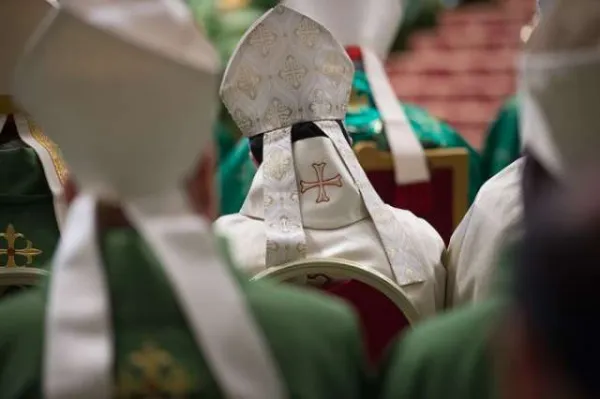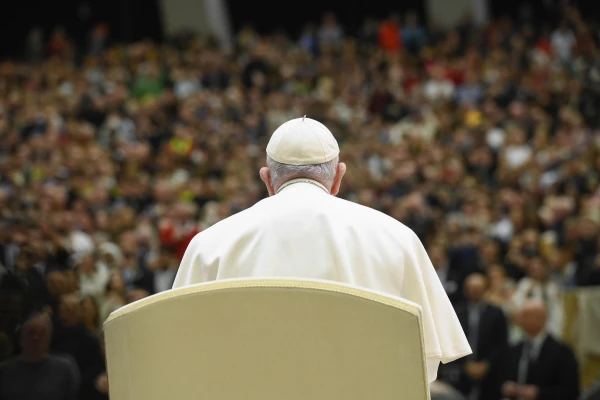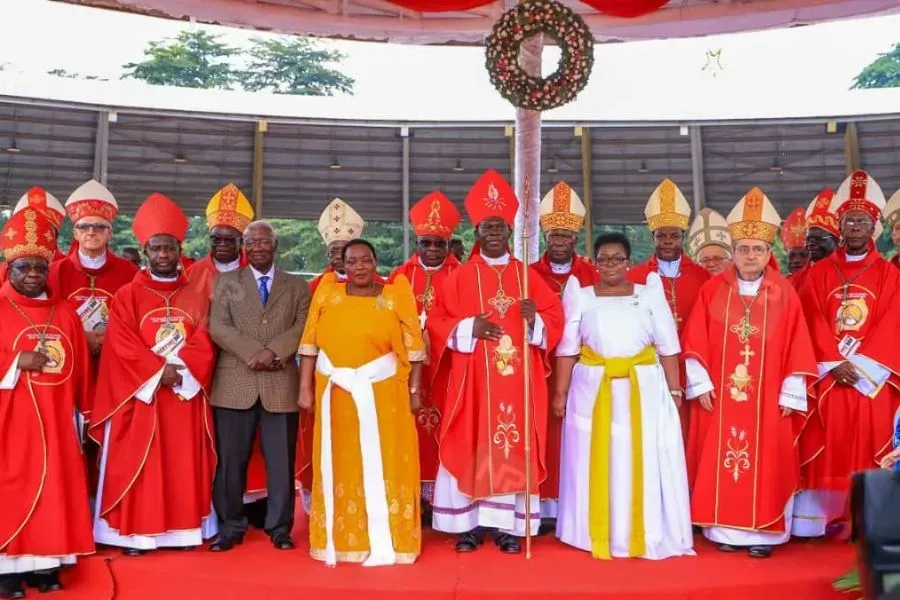Local dioceses organized their synod discussions using the vademecum, or handbook, and the preparatory document issued by the General Secretariat of the Synod in 2021.
How will the Instrumentum Laboris be used in the October synod assembly?
The 50-page Instrumentum Laboris is divided into two sections. The first summarizes insights from the continental assemblies and outlines what a synodal Church is and how it should proceed. The second section is a series of 15 worksheets with questions for discernment.
 Opening Mass for the synod of bishops on the family Oct. 8, 2015. Mazue/catholicnews.org.uk
Opening Mass for the synod of bishops on the family Oct. 8, 2015. Mazue/catholicnews.org.uk
The worksheets will be used to guide the small-group discussions of the October assembly in the Paul VI Hall. The small groups, also called Circuli Minores, will alternate with plenary sessions where all synod participants are together.
(Story continues below)
The last part of the October gathering will focus on deciding the Church’s next steps and “the necessary in-depth theological and canonical studies in preparation” for a second assembly in October 2024.
What are the main questions that the Synod on Synodality will try to answer?
Here are the three overarching questions defined by the 2023 Instrumentum Laboris:
-
How can we be more fully a sign and instrument of union with God and of the unity of all humanity?
-
How can we better share gifts and tasks in the service of the Gospel?
-
“What processes, structures, and institutions in a missionary synodal Church?”
The main objective of the first session in October, according to the Instrumentum Laboris, will be to design a plan of study in a “synodal style” and to indicate who will be involved in those discussions. Discernment will be “completed” in the 2024 session of the synod.
What are some of the topics that could be addressed in the synod assembly?
The Instrumentum Laboris document guiding the discussions at the October synod assembly suggests discernment on questions regarding some hot-button topics, including women deacons, priestly celibacy, and LGBTQ outreach.
The document highlights a desire for new institutional bodies to allow for greater participation in decision-making by the “people of God.” One of the proposed questions for discernment for the synod of bishops asks: “What can we learn about the exercise of authority and responsibility from other Churches and ecclesial communities?”
How does the Synod on Synodality differ from past synods of bishops?
A synod is a meeting of bishops gathered to discuss a topic of theological or pastoral significance in order to prepare a document of advice or counsel to the pope.
For the first time, about 21% of the voting delegates in the 2023 Synod of Bishops on Synodality will not be bishops, and 70 delegates will be chosen directly by the pope from among a list of 140 laypeople, priests, consecrated women, and deacons selected by the leadership of this year’s continental synod meetings. The delegates for the October synod assembly have not yet been announced.
The October assembly will be held in the Paul VI Hall, instead of the Vatican’s New Synod Hall, with delegates sitting at round tables of about 10 people each.
 Pope Francis at his general audience in Paul VI Hall on Feb. 15, 2023. Vatican Media
Pope Francis at his general audience in Paul VI Hall on Feb. 15, 2023. Vatican Media
What other events are happening leading up to the October Vatican assembly?
The 2023 Synod on Synodality assembly at the Vatican will begin with a three-day retreat for the Catholic bishops and participants Oct. 1–3 led by Dominican Father Timothy Radcliffe, who has drawn criticism by some for his statements on homosexuality.
Pope Francis has also announced an ecumenical prayer vigil will take place in St. Peter’s Square as part of the Synod on Synodality on Sept. 30. The prayer vigil, organized by the Taizé Community, will entrust to God the work of the October synod assembly.
How is the participation in the Synod on Synodality?
The General Secretariat of the Synod of Bishops has reported that the initial diocesan listening phase concluded with the participation of 112 out of 114 of the world’s Catholic bishops’ conferences.
According to a report from the U.S. bishops’ conference, about 700,000 people participated in the diocesan phase of the synod in the U.S. out of 66.8 million Catholics in the country, or about 1%.
Who are the key organizers of the Synod on Synodality?
Cardinal Jean-Claude Hollerich, the 64-year-old archbishop of Luxembourg, is one of the leading organizers of the ongoing Synod on Synodality as the relator general. The Jesuit was recently added to Pope Francis’ council of cardinal advisers. Hollerich said in an interview in March that he believes that a future pope could allow women priests and that he finds “the part of the teaching calling homosexuality ‘intrinsically disordered’ a bit dubious.”
Cardinal Mario Grech, the secretary general for the Synod of Bishops, is the former bishop of Gozo, Malta. He was one of two authors of the Maltese bishops’ controversial pastoral guidelines on Amoris Laetitia, which stated that divorced and remarried Catholics, in certain cases and after “honest discernment,” could receive Communion. Last year, Grech decried the public criticism of the German “Synodal Way” as “denunciation.”
What has Pope Francis said about the Synod on Synodality?
On Pentecost this year, Pope Francis said that he sees the Holy Spirit not only as the “soul of the Church” but also as “the heart of synodality.”
He called for the Synod on Synodality to “place the Holy Spirit at the beginning and at the heart of the work of the synod.”
“The synod now taking place is — and should be — a journey in accordance with the Spirit, not a parliament for demanding rights and claiming needs in accordance with the agenda of the world, nor an occasion for following wherever the wind is blowing, but the opportunity to be docile to the breath of the Holy Spirit,” Pope Francis said.
Is there a prayer for the Synod on Synodality?
Pope Francis announced in May that Marian shrines around the world would hold a day of prayer for the 16th Ordinary General Assembly of the Synod of Bishops. Cardinal Grech has also asked men and women in monastic and contemplative religious life to pray for the Church’s ongoing Synod on Synodality.
The vademecum for the synod published the following Prayer for the Synod on Synodality:
“We stand before you, Holy Spirit, as we gather together in your name. With you alone to guide us, make yourself at home in our hearts; teach us the way we must go and how we are to pursue it. We are weak and sinful; do not let us promote disorder. Do not let ignorance lead us down the wrong path nor partiality influence our actions. Let us find in you our unity so that we may journey together to eternal life and not stray from the way of truth and what is right. All this we ask of you, who are at work in every place and time, in the communion of the Father and the Son, forever and ever. Amen.”
Courtney Mares is a Rome Correspondent for Catholic News Agency. A graduate of Harvard University, she has reported from news bureaus on three continents and was awarded the Gardner Fellowship for her work with North Korean refugees.





 Opening Mass for the synod of bishops on the family Oct. 8, 2015. Mazue/catholicnews.org.uk
Opening Mass for the synod of bishops on the family Oct. 8, 2015. Mazue/catholicnews.org.uk Pope Francis at his general audience in Paul VI Hall on Feb. 15, 2023. Vatican Media
Pope Francis at his general audience in Paul VI Hall on Feb. 15, 2023. Vatican Media


